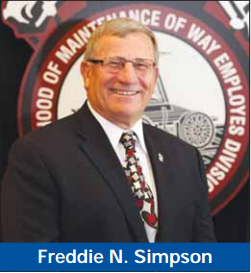2015 April - June President's Perspective: Let us lead the charge for improved track maintenance Published: Jun 30 2015 3:24PM

Virtually every month we hear of an oil train derailing somewhere in North America. In fact, the Department of Transportation (DOT) recently published a report predicting a minimum of 10 oil train derailments per year for the foreseeable future under the current U.S. regulatory scheme. These oil train derailments -- which pose a potential threat to rail workers, the public and the environment -- are often accompanied by fire, explosion, property damage, and evacuation.
So far we have been very lucky that oil train disasters in the U.S. have occurred primarily in rural areas away from population centers. Thankfully, no U.S. citizen has lost his or her life due to the numerous oil train derailments which have occurred over the past year; but the industry cannot rely on luck alone to prevent catastrophic loss of life and property. In 2013, an oil train derailment and massive fire in Quebec, Canada wiped out the town of Lac Megantic, killing 47 citizens and causing an estimated $1 billion in liability damages for the railroad. For the sake and safety of the American public, the railroad industry can and must do better.
According to data published by the Federal Railroad Administration, track conditions are a leading cause of train derailments in the United States, accounting for approximately one-third of all train accidents. FRA statistics confirm 1,220 reportable train derailments occurred in 2014, resulting in nearly $200 million in repair/replacement costs for damaged track and equipment alone, not including the cost to human lives, private property, and the environment. Of these derailments, a full 39 percent (475) were determined to be track caused.
Although we cannot prevent every railroad accident from every conceivable cause, a key to reducing the frequency of oil train derailments is improved track quality through higher maintenance and inspection standards. Railroad companies determine the level of track maintenance they perform and FRA regulates maximum allowable train speed based upon those track conditions. As such, railroads have the ability to reduce track caused derailments significantly by increasing the level and timeliness of track maintenance and assuring there are sufficient BMWED-represented track forces available to keep ahead of the rate of track degradation.
The solution to reducing track-caused derailments is clear; however, the willingness of the industry to take the necessary steps is not as clear. For the sake of rail workers and the American public, BMWED will continue to promote improved track quality as a cornerstone of railroad and oil train safety. BMWED is the only strong and independent voice pushing these issues in rulemaking proceedings and on Capitol Hill. As president, I believe the Brotherhood has a moral obligation to be the voice of the American people on track safety issues. If we don’t do it, it will not get done. If we don’t do it, the accountants and bean counters will continue to roll the dice and hope that luck will prevail over sound track maintenance practices and procedures.
In 2014, there were 649 main line train accidents in the U.S. Of these main line accidents, 329 were classified as derailments and an astounding 47 percent (155) of these were reported by the railroads themselves to be track-caused. BMWED has presented specific, common-sense proposals to FRA and the industry for improving track and rail integrity through a combination of integrated track inspection methods and improvements in the timeliness of track repairs and
other remedial actions. We have also proposed track speed and track class modifications to improve railroad safety and reduce both the occurrence and magnitude of oil train derailments.
Transporting crude oil on U.S. railroads grew from just 9,500 carloads in 2008 to more than 400,000 carloads in 2013. The railroads have been amassing record profits and we want them to continue to be exceptionally profitable. Safety and profitability go hand-in-hand.
We can significantly improve railroad safety -- and the railroad’s bottom line -- by improving the quality of the track. The technology, the highly-skilled BMWED workforce, and our common sense proposals to improve track safety already exist. The only question is, does the industry have the will and the foresight to address these issues head-on, or will the accountants and bean counters continue to prevail over sound railroad engineering and maintenance practices?